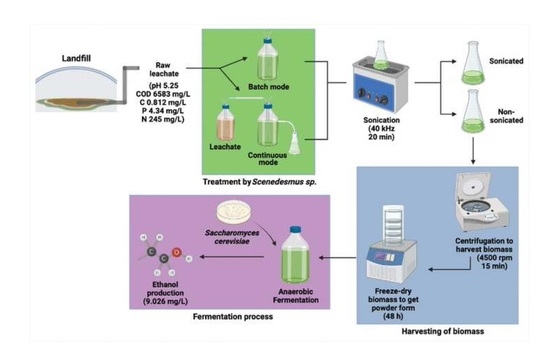Municipal Landfill Leachate Treatment and Sustainable Ethanol Production: A Biogreen Technology Approach
Abstract
:1. Introduction
2. Material and Methods
2.1. Sample Collection
2.2. Algae Strain and Preparation of Cultivation
2.3. Physicochemical Analysis of Leachate
Determination of Carbohydrate Content
2.4. Treatment of Raw Leachate Using Scenedesmus sp. in Batch and Continuous Bioreactors
2.5. Preparation of Biomass
2.6. Conversion of Biomass to Ethanol
3. Results and Discussion
3.1. Physicochemical Characteristics of Raw Leachate
3.2. Comparison of Leachate Treated with Scenedesmus sp. Using Continuous and Batch Modes
3.3. Harvesting and Conversion of Biomass for Ethanol Production
3.3.1. Removal of Nitrogen, Phosphorus, and Carbohydrate
3.3.2. Ethanol Production
4. Conclusions
Author Contributions
Funding
Institutional Review Board Statement
Informed Consent Statement
Data Availability Statement
Conflicts of Interest
References
- Bakraouy, H.; Souabi, S.; Digua, K.; Dkhissi, O.; Sabar, M.; Fadil, M. Optimization of the treatment of an anaerobic pretreated landfill leachate by a coagulation–flocculation process using experimental design methodology. Process Saf. Environ. Prot. 2017, 109, 621–630. [Google Scholar] [CrossRef]
- Wong, Y.; Ho, Y.; Ho, K.; Leung, H.; Yung, K. Growth medium screening for Chlorella vulgaris growth and lipid production. J. Aquac. Mar. Biol. 2017, 6, 00143. [Google Scholar] [CrossRef] [Green Version]
- Aziz, S.Q.; Aziz, H.A.; Yusoff, M.S.; Bashir, M.J.; Umar, M. Leachate characterization in semi-aerobic and anaerobic sanitary landfills: A comparative study. J. Environ. Manag. 2010, 91, 2608–2614. [Google Scholar] [CrossRef]
- Chen, W.; Gu, Z.; Ran, G.; Li, Q. Application of membrane separation technology in the treatment of leachate in China: A review. Waste Manag. 2021, 121, 127–140. [Google Scholar] [CrossRef]
- Jia, H.; Yuan, Q. Removal of nitrogen from wastewater using microalgae and microalgae–bacteria consortia. Cogent Environ. Sci. 2016, 2, 1275089. [Google Scholar] [CrossRef]
- Costa, A.M.; Alfaia, R.G.d.S.M.; Campos, J.C. Landfill leachate treatment in Brazil—An overview. J. Environ. Manag. 2019, 232, 110–116. [Google Scholar] [CrossRef]
- Arij, Y.; Fatihah, S.; Rakmi, A. Performance of pilot scale anaerobic biofilm digester (ABD) for the treatment of leachate from a municipal waste transfer station. Bioresour. Technol. 2018, 260, 213–220. [Google Scholar] [CrossRef] [PubMed]
- Munoz, R.; Malhautier, L.; Fanlo, J.-L.; Quijano, G. Biological technologies for the treatment of atmospheric pollutants. Int. J. Environ. Anal. Chem. 2015, 95, 950–967. [Google Scholar] [CrossRef]
- Talebi, A.; Razali, Y.S.; Ismail, N.; Rafatullah, M.; Tajarudin, H.A. Selective adsorption and recovery of volatile fatty acids from fermented landfill leachate by activated carbon process. Sci. Total Environ. 2020, 707, 134533. [Google Scholar] [CrossRef]
- El Ouaer, M.; Turki, N.; Kallel, A.; Halaoui, M.; Trabelsi, I.; Hassen, A. Recovery of landfill leachate as culture medium for two microalgae: Chlorella sp. and Scenedesmus sp. Environ. Dev. Sustain. 2019, 22, 2651–2671. [Google Scholar] [CrossRef]
- Dogaris, I.; Ammar, E.; Philippidis, G.P. Prospects of integrating algae technologies into landfill leachate treatment. World J. Microbiol. Biotechnol. 2020, 36, 39. [Google Scholar] [CrossRef]
- Rusten, B.; Sahu, A.K. Microalgae growth for nutrient recovery from sludge liquor and production of renewable bioenergy. Water Sci. Technol. 2011, 64, 1195–1201. [Google Scholar] [CrossRef] [PubMed]
- de Souza, L.; Lima, A.S.; Matos, Â.P.; Wheeler, R.M.; Bork, J.A.; Cubas, A.L.V.; Moecke, E.H.S. Biopolishing sanitary landfill leachate via cultivation of lipid-rich Scenedesmus microalgae. J. Clean. Prod. 2021, 303, 127094. [Google Scholar] [CrossRef]
- Miranda, J.; Passarinho, P.C.; Gouveia, L. Pre-treatment optimization of Scenedesmus obliquus microalga for bioethanol production. Bioresour. Technol. 2012, 104, 342–348. [Google Scholar] [CrossRef] [Green Version]
- Nawaz, T.; Rahman, A.; Pan, S.; Dixon, K.; Petri, B.; Selvaratnam, T. A review of landfill leachate treatment by microalgae: Current status and future directions. Processes 2020, 8, 384. [Google Scholar] [CrossRef] [Green Version]
- Ren, H.-Y.; Liu, B.-F.; Ma, C.; Zhao, L.; Ren, N.-Q. A new lipid-rich microalga Scenedesmus sp. strain R-16 isolated using Nile red staining: Effects of carbon and nitrogen sources and initial pH on the biomass and lipid production. Biotechnol. Biofuels 2013, 6, 143. [Google Scholar] [CrossRef] [PubMed] [Green Version]
- Walls, L.E.; Velasquez-Orta, S.B.; Romero-Frasca, E.; Leary, P.; Noguez, I.Y.; Ledesma, M.T.O. Non-sterile heterotrophic cultivation of native wastewater yeast and microalgae for integrated municipal wastewater treatment and bioethanol production. Biochem. Eng. J. 2019, 151, 107319. [Google Scholar] [CrossRef]
- Iasimone, F.; Zuccaro, G.; D’Oriano, V.; Franci, G.; Galdiero, M.; Pirozzi, D.; de Felice, V.; Pirozzi, F. Combined yeast and microalgal cultivation in a pilot-scale raceway pond for urban wastewater treatment and potential biodiesel production. Water Sci. Technol. 2017, 77, 1062–1071. [Google Scholar] [CrossRef] [PubMed]
- Qin, L.; Wei, D.; Wang, Z.; Alam, M.A. Advantage assessment of mixed culture of Chlorella vulgaris and Yarrowia lipolytica for treatment of liquid digestate of yeast industry and cogeneration of biofuel feedstock. Appl. Biochem. Biotechnol. 2019, 187, 856–869. [Google Scholar] [CrossRef]
- Romero-Frasca, E.; Velasquez-Orta, S.B.; Escobar-Sánchez, V.; Tinoco-Valencia, R.; Ledesma, M.T.O. Bioprospecting of wild type ethanologenic yeast for ethanol fuel production from wastewater-grown microalgae. Biotechnol. Biofuels 2021, 14, 93. [Google Scholar] [CrossRef]
- Aziz, H.A.; Adlan, M.N.; Amilin, K.; Yusoff, M.; Ramly, N.H.; Umar, M. Quantification of leachate generation rate from a semi-aerobic landfill in Malaysia. Environ. Eng. Manag. J. 2012, 11, 1581–1585. [Google Scholar] [CrossRef]
- Shah, M.; Alam, M.; Mia, M. Chlorella sp.: Isolation, pure culture and small scale culture in brackish-water. Bangladesh J. Sci. Ind. Res. 2003, 38, 165–174. [Google Scholar]
- Ismail, S.N.S.; Manaf, L.A. The challenge of future landfill: A case study of Malaysia. J. Toxicol. Environ. Health Sci. 2013, 5, 86–96. [Google Scholar] [CrossRef]
- Dogaris, I.; Loya, B.; Cox, J.; Philippidis, G. Study of landfill leachate as a sustainable source of water and nutrients for algal biofuels and bioproducts using the microalga Picochlorum oculatum in a novel scalable bioreactor. Bioresour. Technol. 2019, 282, 18–27. [Google Scholar] [CrossRef]
- Sharma, J.; Kumar, S.S.; Bishnoi, N.R.; Pugazhendhi, A. Enhancement of lipid production from algal biomass through various growth parameters. J. Mol. Liq. 2018, 269, 712–720. [Google Scholar] [CrossRef]
- Li, W.; Zhang, H.-Y.; Sun, H.-Z.; Zeng, F.; Gao, Y.-N.; Zhu, L. Influence of pH on short-cut denitrifying phosphorus removal. Water Sci. Eng. 2018, 11, 17–22. [Google Scholar] [CrossRef]
- Gómez-Pérez, C.; Espinosa, J. The design analysis of continuous bioreactors in series with recirculation using Singular Value Decomposition. Chem. Eng. Res. Des. 2017, 125, 108–118. [Google Scholar] [CrossRef]
- Tighiri, H.O. Effect of aeration flow rate on the growth of microalgae as a biofuel feedstock and wastewater treatment. New Trends Issues Proc. Humanit. Soc. Sci. 2017, 4, 195–204. [Google Scholar] [CrossRef]
- Wagner, J.L.; Le, C.D.; Ting, V.P.; Chuck, C. Design and operation of an inexpensive, laboratory-scale, continuous hydrothermal liquefaction reactor for the conversion of microalgae produced during wastewater treatment. Fuel Process. Technol. 2017, 165, 102–111. [Google Scholar] [CrossRef] [Green Version]
- Ungureanu, N.; Vladut, V.; Biris, S.-S. Capitalization of wastewater-grown algae in bioethanol production. In Proceedings of the 19th International Scientific Conference, Engineering for Rural Development, Latvia University of Life Sciences and Technologies, Jelgava, Latvia, 20–22 May 2020. [Google Scholar]
- Bader, A.N.; Rizza, L.S.; Consolo, V.F.; Curatti, L. Efficient saccharification of microalgal biomass by Trichoderma harzianum enzymes for the production of ethanol. Algal Res. 2020, 48, 101926. [Google Scholar] [CrossRef]
- Gohain, M.; Hasin, M.; Eldiehy, K.S.; Bardhan, P.; Laskar, K.; Phukon, H.; Mandal, M.; Kalita, D.; Deka, D. Bio-ethanol production: A route to sustainability of fuels using bio-based heterogeneous catalyst derived from waste. Process Saf. Environ. Prot. 2021, 146, 190–200. [Google Scholar] [CrossRef]
- Arora, N.; Laurens, L.M.; Sweeney, N.; Pruthi, V.; Poluri, K.M.; Pienkos, P.T. Elucidating the unique physiological responses of halotolerant Scenedesmus sp. cultivated in sea water for biofuel production. Algal Res. 2019, 37, 260–268. [Google Scholar]
- Shahid, A.; Malik, S.; Zhu, H.; Xu, J.; Nawaz, M.Z.; Nawaz, S.; Alam, M.A.; Mehmood, M.A. Cultivating microalgae in wastewater for biomass production, pollutant removal, and atmospheric carbon mitigation; a review. Sci. Total Environ. 2020, 704, 135303. [Google Scholar] [CrossRef] [PubMed]
- Zhang, Y.; Yang, S.; Zhang, H.; Hou, Y.; Zhang, J.; Chen, F.; Hu, X. Degradation of Methamidophos in Apple Juice by Ultrasonic Treatment. Food Ferment. Ind. 2010, 12, 80–83. [Google Scholar]
- Rodriguez-Caballero, A.; Ramond, J.-B.; Welz, P.; Cowan, D.; Odlare, M.; Burton, S. Treatment of high ethanol concentration wastewater by biological sand filters: Enhanced COD removal and bacterial community dynamics. J. Environ. Manag. 2012, 109, 54–60. [Google Scholar] [CrossRef]
- Özçimen, D.; İnan, B.; Biernat, K. An overview of bioethanol production from algae. Biofuels-Status Perspect. 2015, 30, 141–162. [Google Scholar]
- Lin, Y.; Zhang, W.; Li, C.; Sakakibara, K.; Tanaka, S.; Kong, H.J.B. Factors affecting ethanol fermentation using Saccharomyces cerevisiae BY4742. Biomass Bioenergy 2012, 47, 395–401. [Google Scholar] [CrossRef]

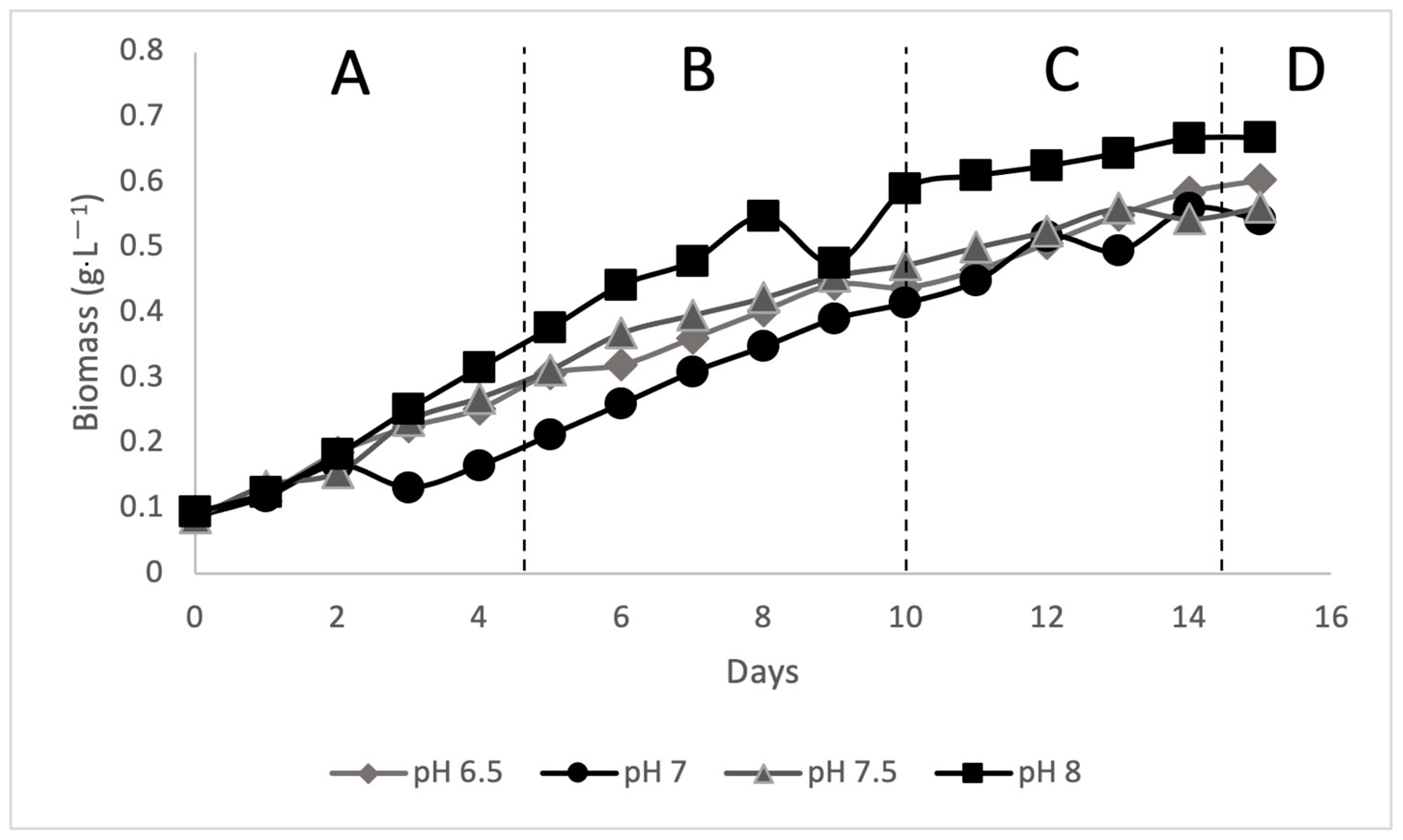
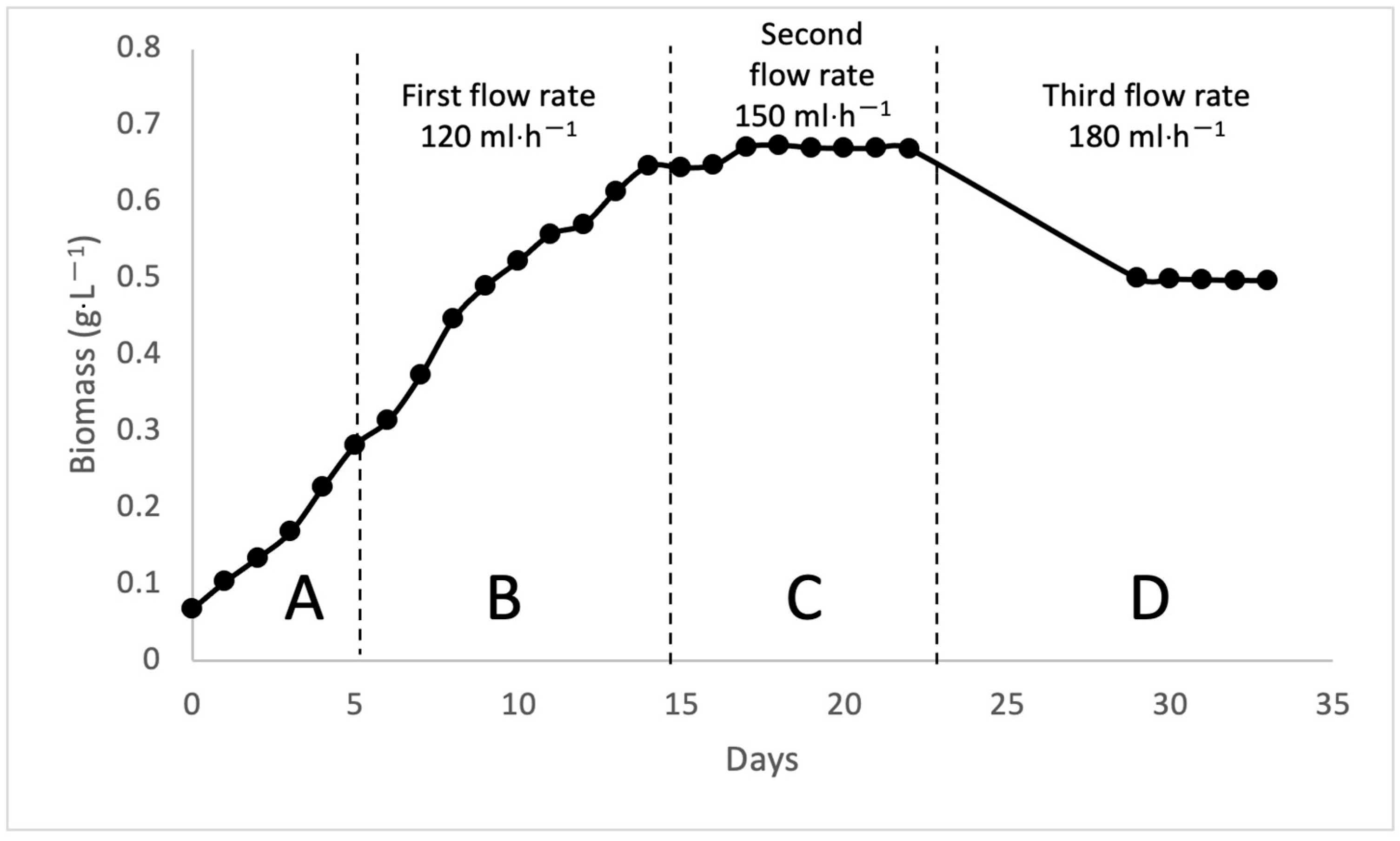
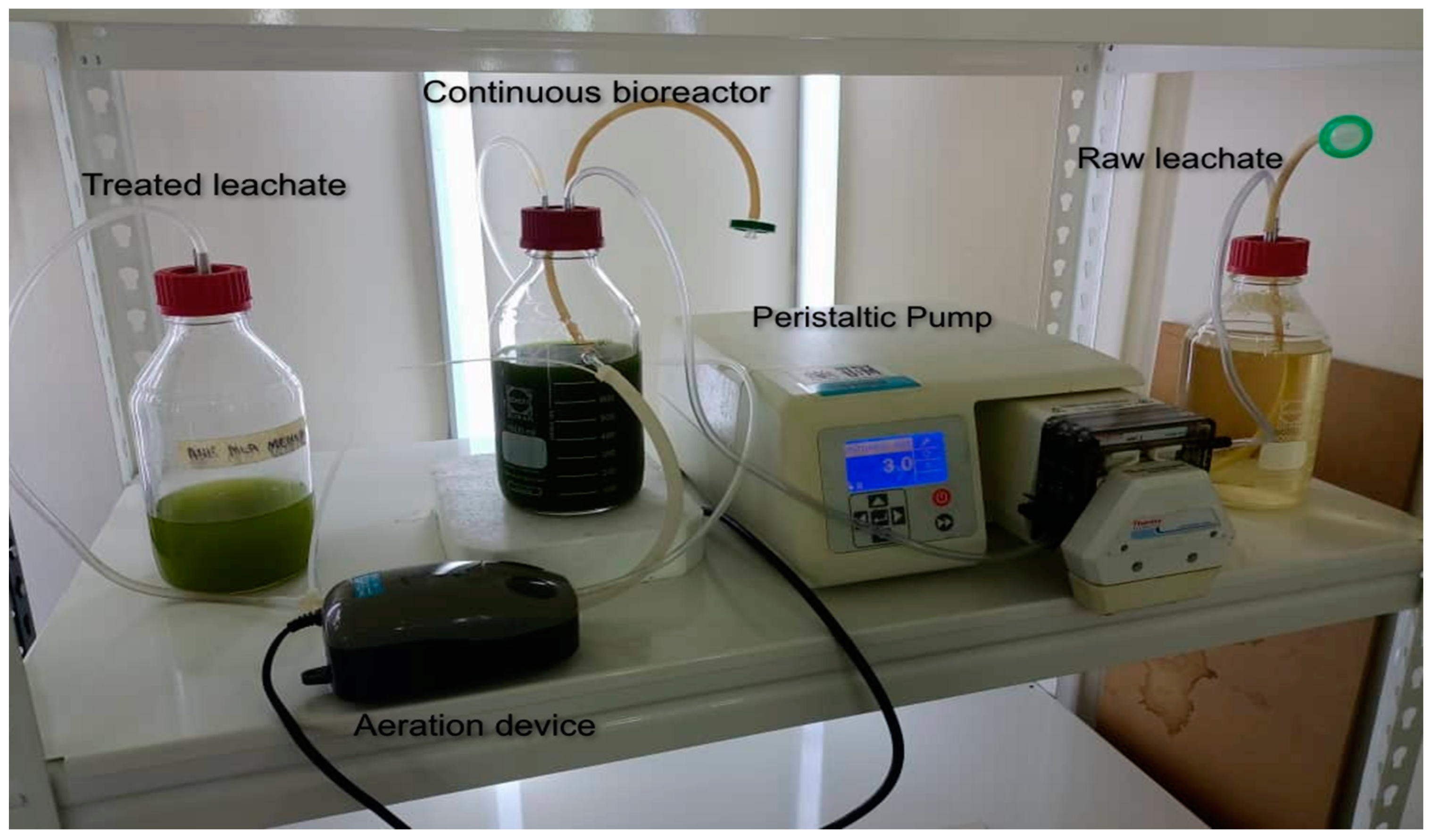
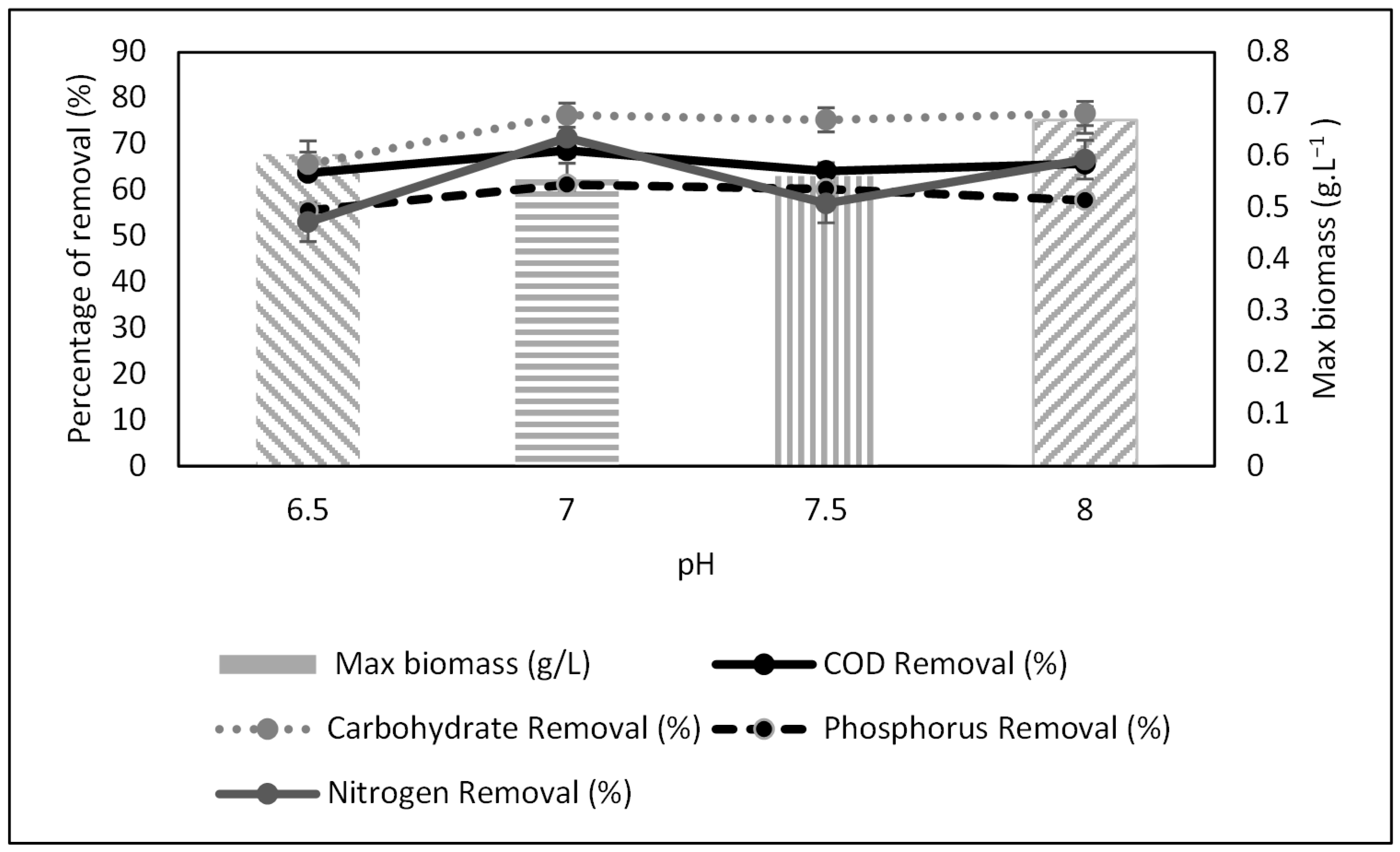
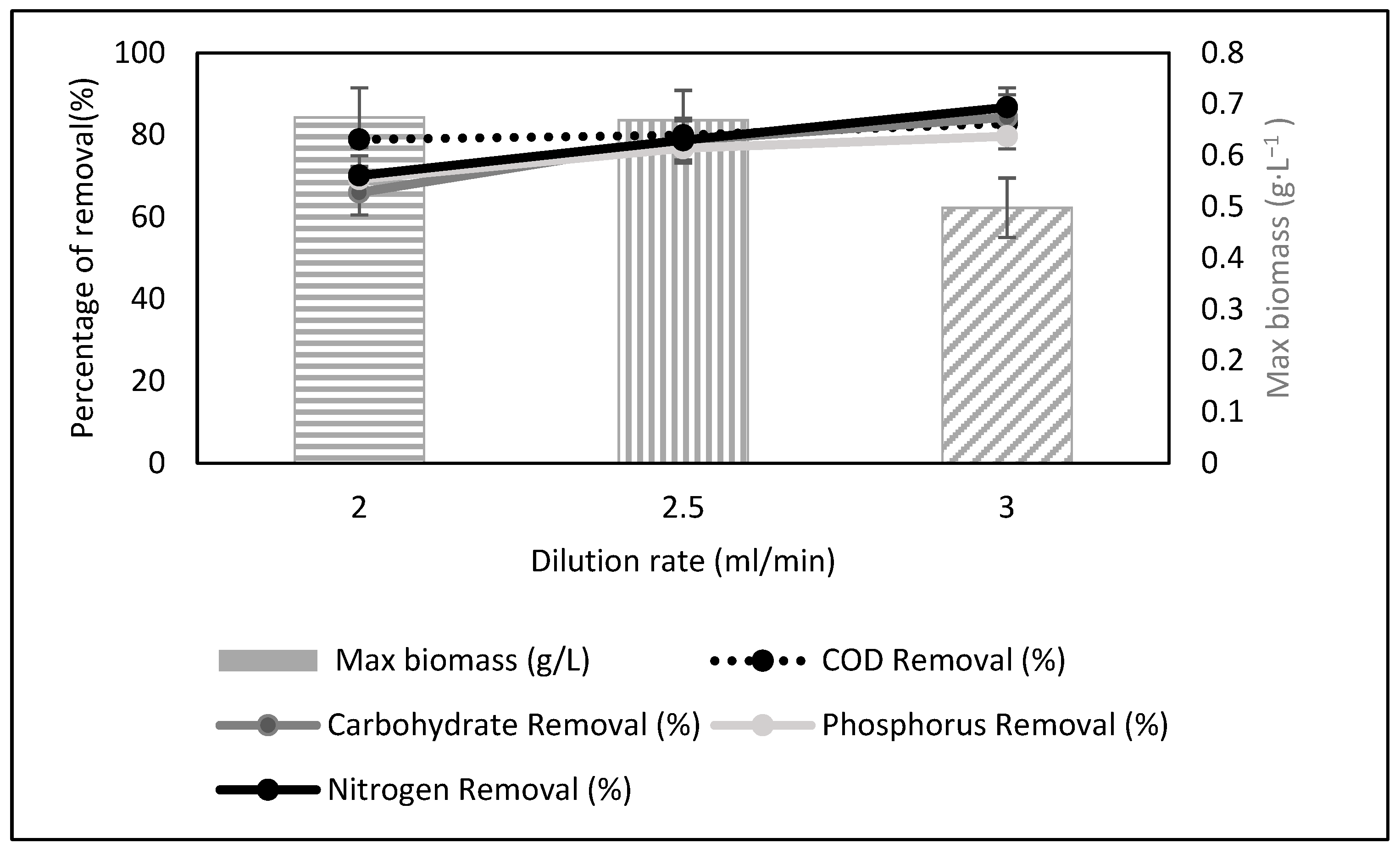
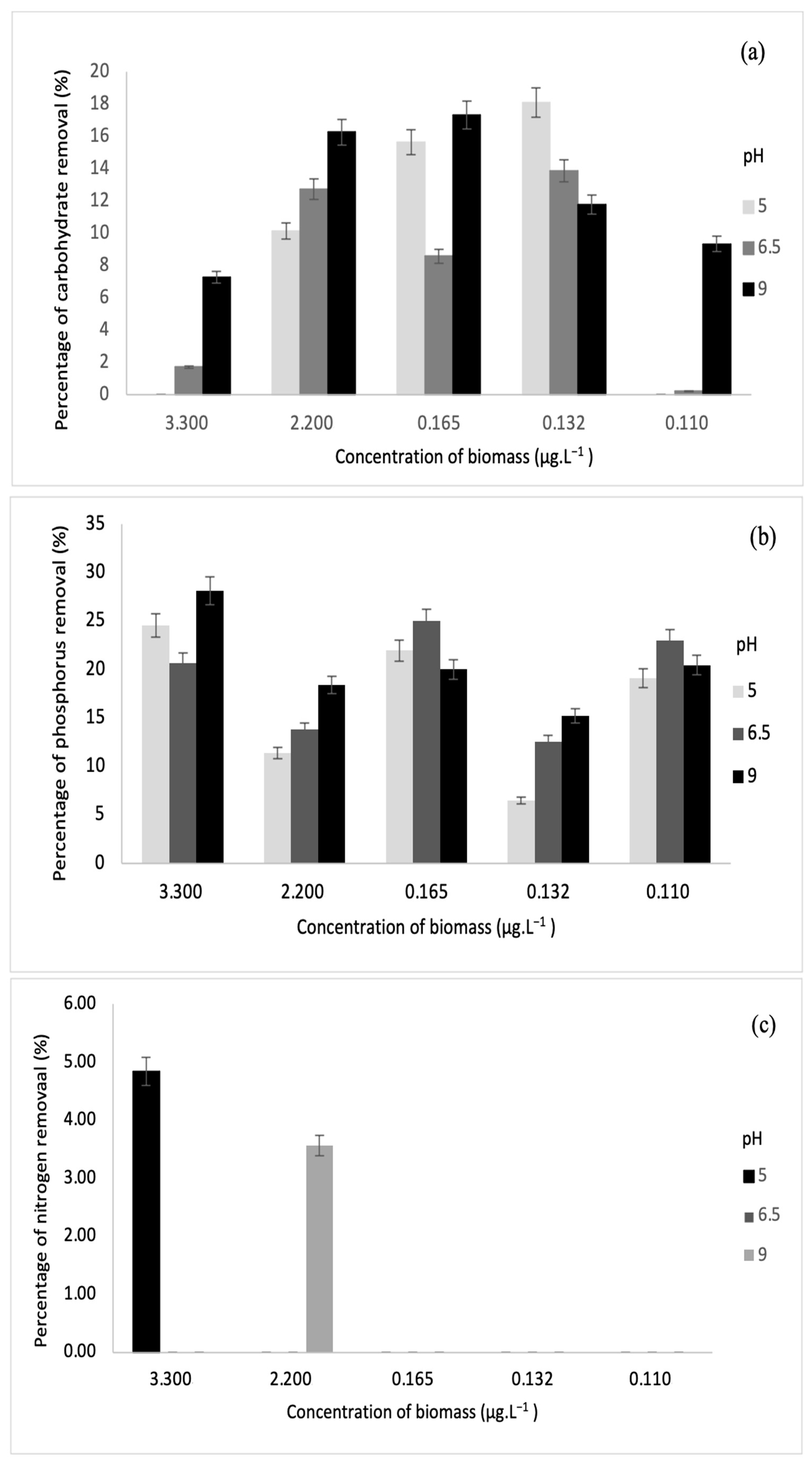
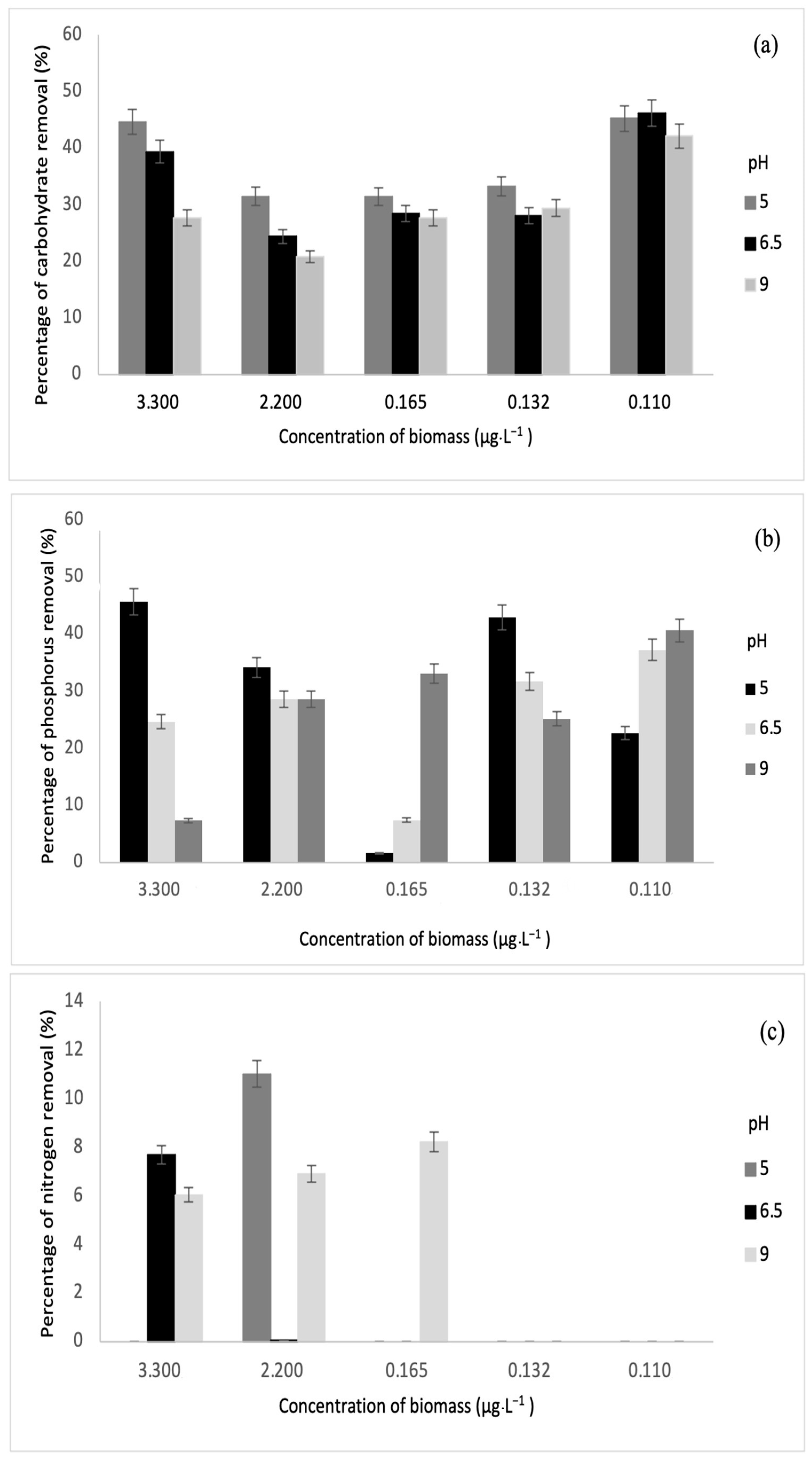
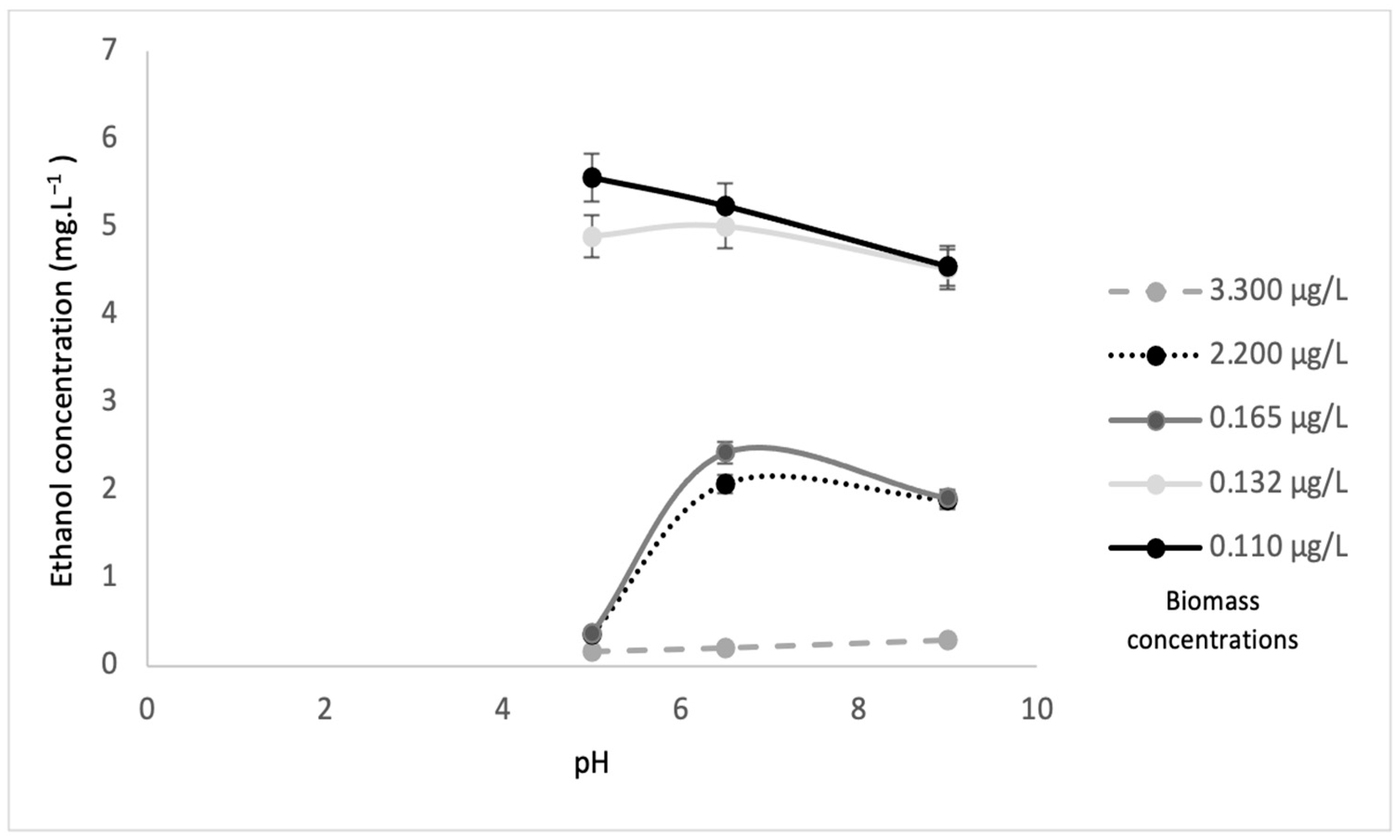
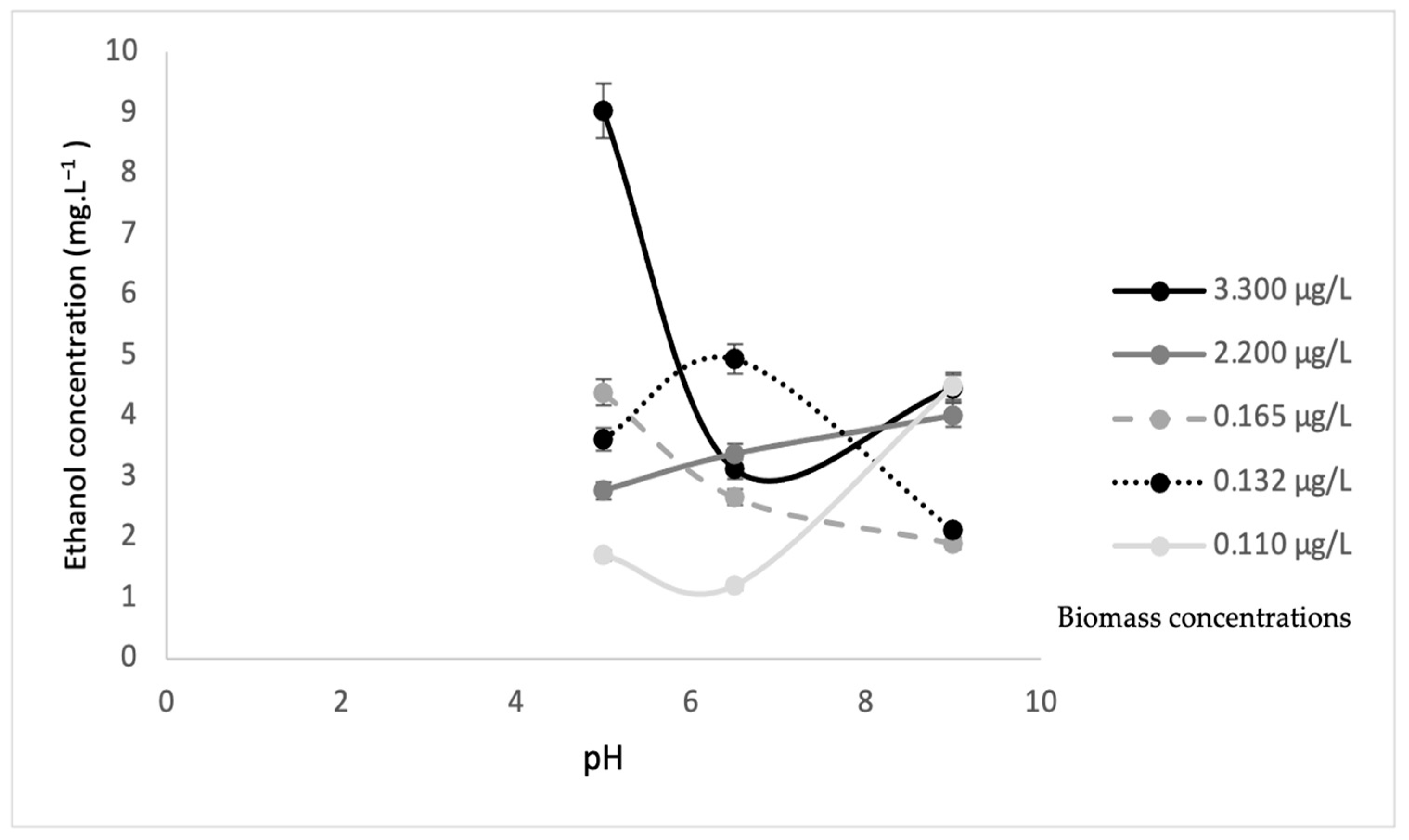
| Characteristics | Value |
|---|---|
| pH | 5.250 |
| Chemical oxygen demand, COD | 6583 mg·L−1 |
| Carbohydrate content | 0.812 mg·L−1 |
| Phosphorus content | 4.340 mg·L−1 |
| Total Kjeldahl nitrogen content (TKN) | 245 mg·L−1 |
| Parameter | Ethanol Concentration (mg·L−1) | Maximum Biomass of S. cerevisiae (mg·L−1) | |||
|---|---|---|---|---|---|
| Biomass Concentration (μg·L−1) | pH | With Sonication | Without Sonication | With Sonication | Without Sonication |
| 5 | 0.165 | 9.026 | 0.0361 | 0.0131 | |
| 3.300 | 6.5 | 0.205 | 3.124 | 0.0387 | 0.0131 |
| 9 | 0.291 | 4.450 | 0.0388 | 0.0290 | |
| 5 | 0.355 | 2.769 | 0.0304 | 0.0414 | |
| 2.200 | 6.5 | 2.075 | 3.376 | 0.0333 | 0.0455 |
| 9 | 1.885 | 4.016 | 0.0285 | 0.0526 | |
| 5 | 0.370 | 4.386 | 0.0451 | 0.0565 | |
| 0.165 | 6.5 | 2.430 | 2,658 | 0.0272 | 0.0420 |
| 9 | 1.909 | 1.901 | 0.0272 | 0.0370 | |
| 5 | 4.891 | 3,613 | 0.0571 | 0.0420 | |
| 0.132 | 6.5 | 5.002 | 4.939 | 0.0572 | 0.0400 |
| 9 | 4.521 | 2.114 | 0.0613 | 0.0395 | |
| 5 | 5.562 | 1.704 | 0.0631 | 0.0459 | |
| 0.110 | 6.5 | 5.239 | 1.199 | 0.0653 | 0.0465 |
| 9 | 4.552 | 4.489 | 0.0639 | 0.0467 |
Publisher’s Note: MDPI stays neutral with regard to jurisdictional claims in published maps and institutional affiliations. |
© 2022 by the authors. Licensee MDPI, Basel, Switzerland. This article is an open access article distributed under the terms and conditions of the Creative Commons Attribution (CC BY) license (https://creativecommons.org/licenses/by/4.0/).
Share and Cite
Abobaker, M.S.A.; Tajarudin, H.A.; Ahmad, A.L.; Wan Omar, W.M.; Chun, C.N.W. Municipal Landfill Leachate Treatment and Sustainable Ethanol Production: A Biogreen Technology Approach. Microorganisms 2022, 10, 880. https://doi.org/10.3390/microorganisms10050880
Abobaker MSA, Tajarudin HA, Ahmad AL, Wan Omar WM, Chun CNW. Municipal Landfill Leachate Treatment and Sustainable Ethanol Production: A Biogreen Technology Approach. Microorganisms. 2022; 10(5):880. https://doi.org/10.3390/microorganisms10050880
Chicago/Turabian StyleAbobaker, Mahmod Sidati Ali, Husnul Azan Tajarudin, Abdul Latif Ahmad, Wan Maznah Wan Omar, and Charles Ng Wai Chun. 2022. "Municipal Landfill Leachate Treatment and Sustainable Ethanol Production: A Biogreen Technology Approach" Microorganisms 10, no. 5: 880. https://doi.org/10.3390/microorganisms10050880
APA StyleAbobaker, M. S. A., Tajarudin, H. A., Ahmad, A. L., Wan Omar, W. M., & Chun, C. N. W. (2022). Municipal Landfill Leachate Treatment and Sustainable Ethanol Production: A Biogreen Technology Approach. Microorganisms, 10(5), 880. https://doi.org/10.3390/microorganisms10050880







